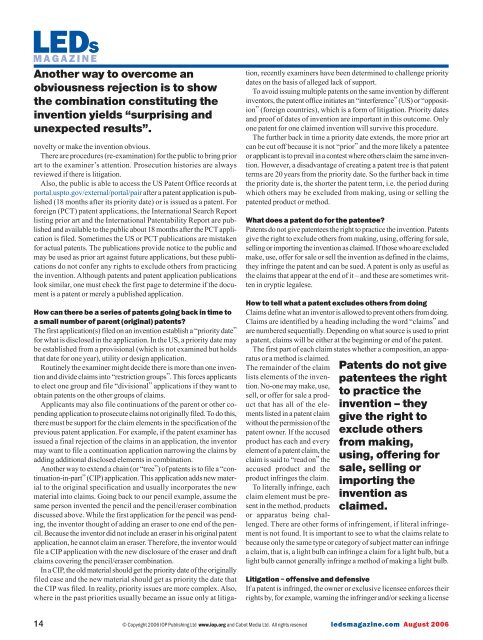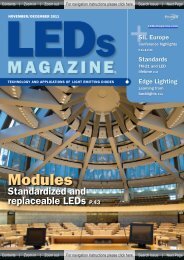LEDs Magazine Review - Beriled
LEDs Magazine Review - Beriled
LEDs Magazine Review - Beriled
- No tags were found...
You also want an ePaper? Increase the reach of your titles
YUMPU automatically turns print PDFs into web optimized ePapers that Google loves.
LEDSMAGAZINEAnother way to overcome anobviousness rejection is to showthe combination constituting theinvention yields “surprising andunexpected results”.novelty or make the invention obvious.There are procedures (re-examination) for the public to bring priorart to the examiner’s attention. Prosecution histories are alwaysreviewed if there is litigation.Also, the public is able to access the US Patent Office records atportal.uspto.gov/external/portal/pair after a patent application is published(18 months after its priority date) or is issued as a patent. Forforeign (PCT) patent applications, the International Search Reportlisting prior art and the International Patentability Report are publishedand available to the public about 18 months after the PCT applicationis filed. Sometimes the US or PCT publications are mistakenfor actual patents. The publications provide notice to the public andmay be used as prior art against future applications, but these publicationsdo not confer any rights to exclude others from practicingthe invention. Although patents and patent application publicationslook similar, one must check the first page to determine if the documentis a patent or merely a published application.How can there be a series of patents going back in time toa small number of parent (original) patents?The first application(s) filed on an invention establish a “priority date”for what is disclosed in the application. In the US, a priority date maybe established from a provisional (which is not examined but holdsthat date for one year), utility or design application.Routinely the examiner might decide there is more than one inventionand divide claims into “restriction groups”. This forces applicantsto elect one group and file “divisional” applications if they want toobtain patents on the other groups of claims.Applicants may also file continuations of the parent or other copendingapplication to prosecute claims not originally filed. To do this,there must be support for the claim elements in the specification of theprevious patent application. For example, if the patent examiner hasissued a final rejection of the claims in an application, the inventormay want to file a continuation application narrowing the claims byadding additional disclosed elements in combination.Another way to extend a chain (or “tree”) of patents is to file a “continuation-in-part”(CIP) application. This application adds new materialto the original specification and usually incorporates the newmaterial into claims. Going back to our pencil example, assume thesame person invented the pencil and the pencil/eraser combinationdiscussed above. While the first application for the pencil was pending,the inventor thought of adding an eraser to one end of the pencil.Because the inventor did not include an eraser in his original patentapplication, he cannot claim an eraser. Therefore, the inventor wouldfile a CIP application with the new disclosure of the eraser and draftclaims covering the pencil/eraser combination.In a CIP, the old material should get the priority date of the originallyfiled case and the new material should get as priority the date thatthe CIP was filed. In reality, priority issues are more complex. Also,where in the past priorities usually became an issue only at litigation,recently examiners have been determined to challenge prioritydates on the basis of alleged lack of support.To avoid issuing multiple patents on the same invention by differentinventors, the patent office initiates an “interference” (US) or “opposition”(foreign countries), which is a form of litigation. Priority datesand proof of dates of invention are important in this outcome. Onlyone patent for one claimed invention will survive this procedure.The further back in time a priority date extends, the more prior artcan be cut off because it is not “prior” and the more likely a patenteeor applicant is to prevail in a contest where others claim the same invention.However, a disadvantage of creating a patent tree is that patentterms are 20 years from the priority date. So the further back in timethe priority date is, the shorter the patent term, i.e. the period duringwhich others may be excluded from making, using or selling thepatented product or method.What does a patent do for the patentee?Patents do not give patentees the right to practice the invention. Patentsgive the right to exclude others from making, using, offering for sale,selling or importing the invention as claimed. If those who are excludedmake, use, offer for sale or sell the invention as defined in the claims,they infringe the patent and can be sued. A patent is only as useful asthe claims that appear at the end of it – and these are sometimes writtenin cryptic legalese.Patents do not givepatentees the rightto practice theinvention – theygive the right toexclude othersfrom making,using, offering forsale, selling orimporting theinvention asclaimed.How to tell what a patent excludes others from doingClaims define what an inventor is allowed to prevent others from doing.Claims are identified by a heading including the word “claims” andare numbered sequentially. Depending on what source is used to printa patent, claims will be either at the beginning or end of the patent.The first part of each claim states whether a composition, an apparatusor a method is claimed.The remainder of the claimlists elements of the invention.No-one may make, use,sell, or offer for sale a productthat has all of the elementslisted in a patent claimwithout the permission of thepatent owner. If the accusedproduct has each and everyelement of a patent claim, theclaim is said to “read on” theaccused product and theproduct infringes the claim.To literally infringe, eachclaim element must be presentin the method, productsor apparatus being challenged.There are other forms of infringement, if literal infringementis not found. It is important to see to what the claims relate tobecause only the same type or category of subject matter can infringea claim, that is, a light bulb can infringe a claim for a light bulb, but alight bulb cannot generally infringe a method of making a light bulb.Litigation – offensive and defensiveIf a patent is infringed, the owner or exclusive licensee enforces theirrights by, for example, warning the infringer and/or seeking a license14© Copyright 2006 IOP Publishing Ltd www.iop.org and Cabot Media Ltd. All rights reservedledsmagazine.com August 2006
















